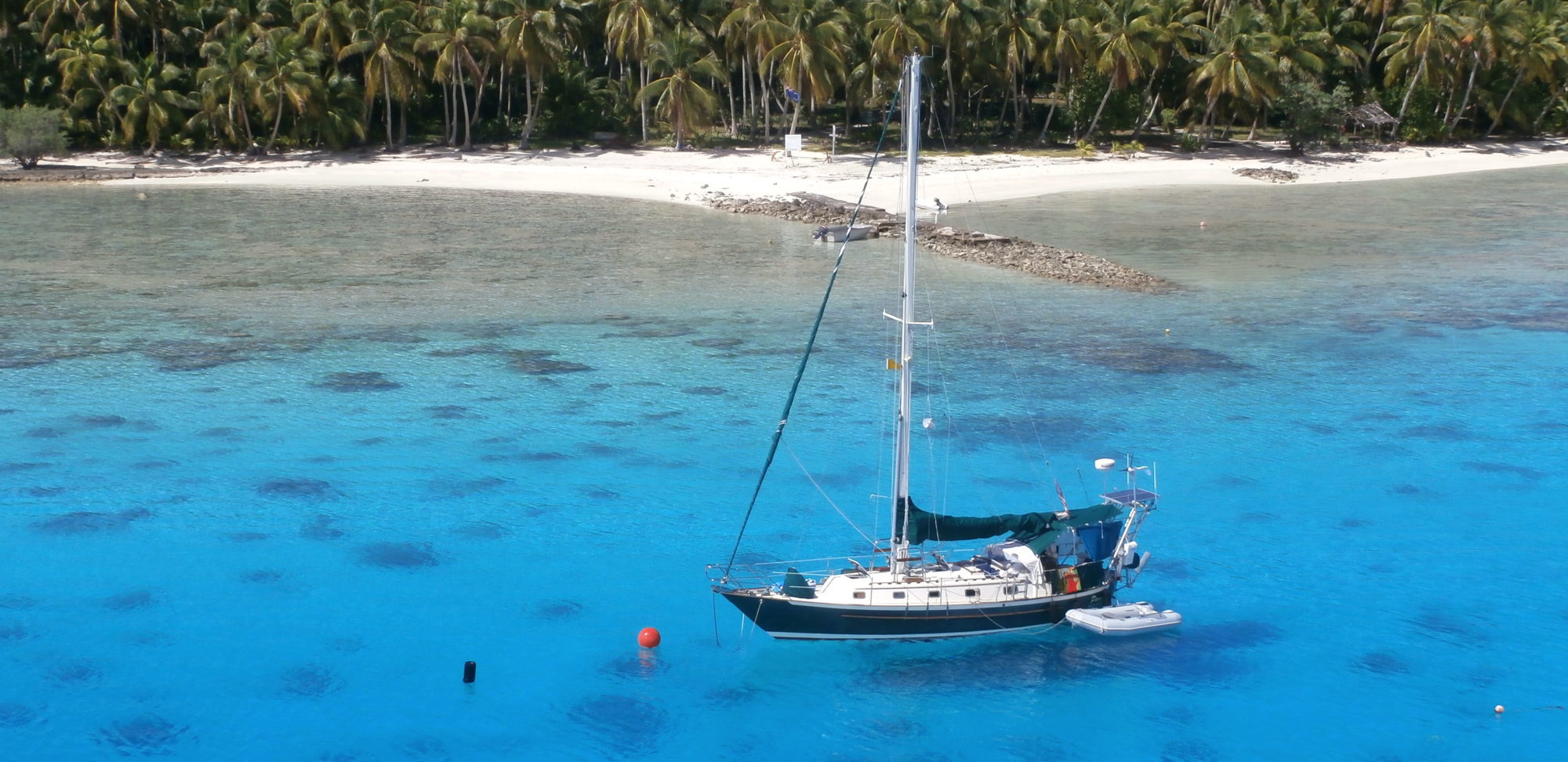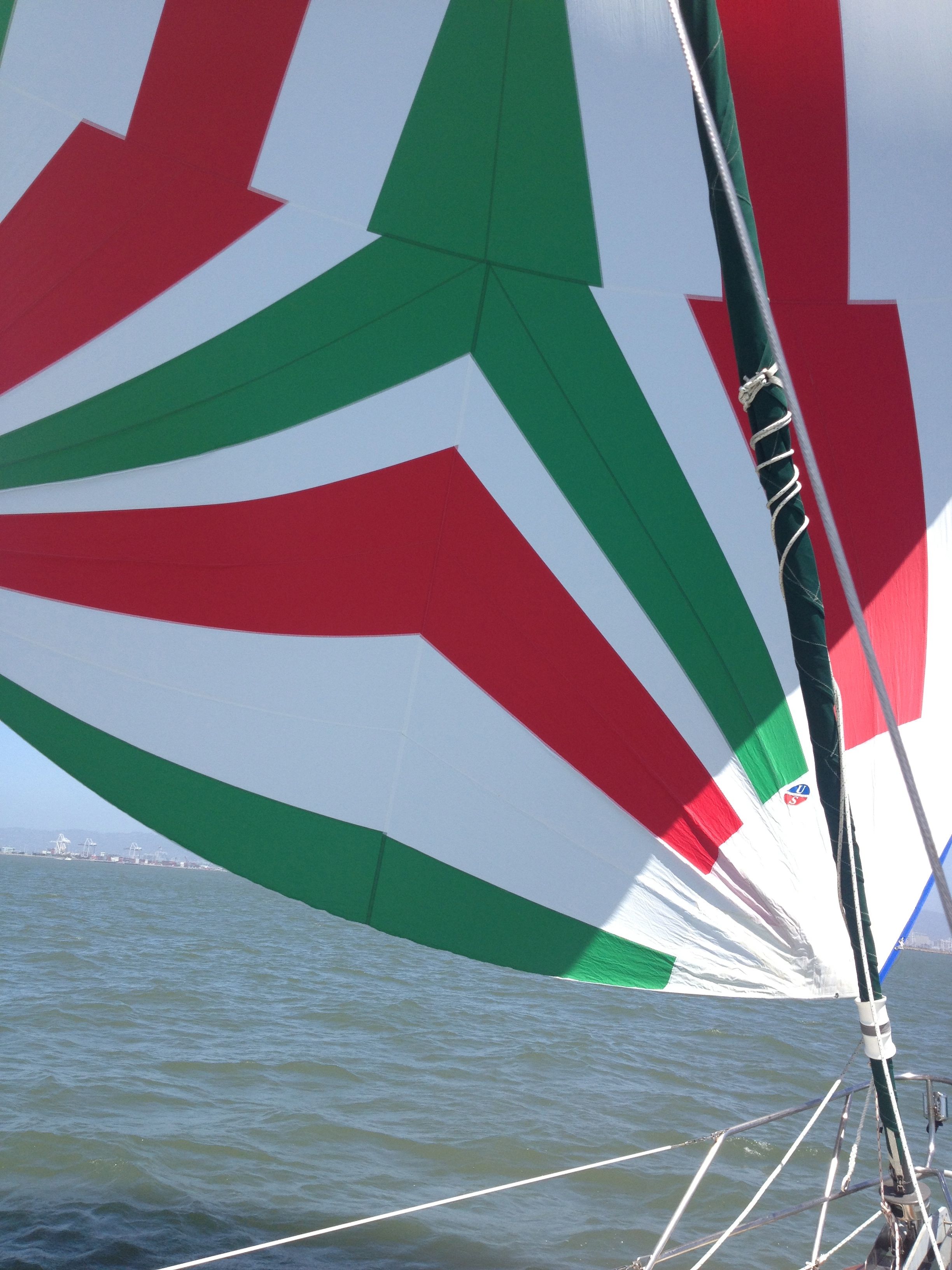Check out the short video Quiet Mind, Endless Sea: Part 1. It describes how I found the Crealock 37 and began preparing her for a voyage across the South Pacific voyage. See my puppy Little Bear’s reaction to going aboard Pamela.
The Spinnaker
It was a positive feeling of sweet ecstasy. I drifted down off the cloud and felt my body settling down back on Earth. I tried singing the chorus to Leonard Cohen’s Hallelujah but not much sound came from my lips. Pam was massaging my feet and Dr. Shinghal was asking me how I felt.
“Really great. Can we do this again next week?”
He smiled. He knew the anesthesia would soon wear off and I would realize I had a catheter sticking out of my John Thomas and I wouldn’t feel like singing Leonard Cohen.
What had I just been dreaming of? Ah yes — sailing Pamela fast downwind on a broad reach through warm tropical waters.
A man moaned silently behind a curtain next to me. “How is the pain now?” a nurse asked him.
“Oohhh…” he murmured. I felt a rush of compassion for him. A hospital is a good place to come to feel compassion.
I had been worried about this prostate procedure. The previous weeks had been full of apprehension and imagined side affects.
What if they cut off my member by mistake and then sewed it to my forehead, so that every time I got excited I looked like a unicorn?
The man moaned again. The nurse asked Pam to leave the shared recovery room so the man could have some privacy.
I closed my eyes and listened to the heart rate monitor beside me. Could I change my heart rate just by thinking about it? With a few deep breaths I found I could. The beeping slowed a bit, then rose as I thought of things I had to do, like preparing Pamelafor extended offshore cruising. A couple deep breaths, imagining myself under a mango tree in Kalalau Valley in the remote northwest corner of Kauai. Sure enough, the heart monitor slowed its pace. Experimenting further, I imagined I was in a staff meeting at Apple discussing deadlines, constrained resources, and online payment methods in emerging markets. There was a perceptible uptick on the monitor.
How long would I be in this recovery room? I wanted to get back to my reading of Offshore Cruising Companion. I noticed my stomach tightening, and with an out-breath I let the tinge of anxiety go. I closed my eyes again and practiced not thinking. I’m getting good at not thinking (not!) — I can now go for nearly 15 seconds before my mind resumes its assembly line of mundane headlines. As my mind began to drift I thought of flying Pamela’s spinnaker on a downwind run.
What a spinnaker! With red, white, and green markings it resembled an Italian flag and made me hungry for a pizza. It seemed brand new when I first pulled a corner of it from its sail bag last year. For over a year it lay in the sail bag as I constantly hauled it around the boat’s cabin looking for a better place to stow it. But I was afraid of it. I was frightened of wrestling down a full spinnaker in a rising wind while driving Pamela’s 16,000 pounds over breaking waves at eight knots. Out of the sail bag I pulled only a small section of sail. I saw that it had a “sock” device and some heavy bits of hardware attaching it to the sock.
“What kind of spinnaker is it?” asked TJ, my sailing instructor. “Is it symmetrical, asymmetrical, or code zero?”
“Oh .. it’s asymmetrical I think, or maybe its symmetrical.”
He looked at me with his head cocked to one side. “Does it have sheets or guys? How does it tack down? Do you have a pole?”
“Well, um, yes, I think there’s a sheet. There’s some lines sticking out…”
“Have you hoisted it?”
Hoisted it? I was afraid to take it out of the sail bag. How could I possibly hoist it? I didn’t even know what sort of spinnaker it actually was. I managed to convince TJ that I had absolutely no clue about my spinnaker, nor whether it even was a spinnaker.
“We should take a look at it,” he suggested. “You’ll want it when you sail the downwind trades to Polynesia.” TJ was teaching a spinnaker class on a 35-foot “J” racing boat. On the lightweight J/105 I handled the asymmetrical spinnaker with ease and even managed to gybe it singlehanded in full control by the end of the class. Pamela’s rig is larger and heavier than the J and seemed to me like it was orders of magnitude more complex. Having TJ show me how it worked would be a smart move. Did I want to actually fly Pamela’s spinnaker to the Marquesas or just pretend, telling other sailors, “Oh yes, I have a spinnaker. It’s in that bag right there. I haven’t figured out how to get it out of the bag. Here, let me move it off this seat so we can sit and have a beer.”
So I did some homework before TJ came to the boat. I pulled the spinnaker from the bag — so far so good — and then hauled it up through the forward hatch and onto the deck. Johnny M was there to make sure I didn’t pitchpole or capsize while Pamela was tied fast to the dock. We found the sail’s head, tack, and clew, fastened the spinnaker halyard, and then raised it a few feet off the deck.
“You see how this sock works?” Johnny M pointed to the bell-shaped fiberglass ring on the end of what resembled a giant sausage casing. “This line raises the sock, which uncovers the sail, and this one covers it back up as it lowers the sock down over the sail. Simple.”
“What if something happens?”
“Like what?”
“Well, what if it gets out of control or there’s a flying uncontrolled gybe, or maybe a broach?”
“Then you lower the sock and take the sail down.”
“And what if you can’t lower it because there’s too much force on the sail and a line squall is coming up fast on the horizon?”
“You can lower it. You sail a little further downwind to blanket the spinnaker with the main and this takes the pressure off the spinnaker, and then you can pull the sock down over it. It’s easy. It’s not rocket science.”
To Johnny M, nothing on a boat was rocket science. It was just “stuff” and you could figure it out. Except my SSB and SailMail modem with counterpoise antenna interfaced with GPS and AIS. To Johnny M, that was closer to rocket science. But a sail was a sail, and a spinnaker was just a big sail, and this particular spinnaker made you hungry for a pizza. It might be hard to get a take-out pizza in the Tuamotu Archipelago, but sailing there with this spinnaker would be easy.
And thus I learned that Pamela’s spinnaker was asymmetric — a modern, easy-to-handle design — nearly brand new, and could probably be handled by Pam and me without much yelling and cursing.
A few weeks later I met TJ on the boat and we rigged up a collar to hold down the tack of the sail and sheets on port and starboard to control the trim. No foreguys, after-guys, or spinnaker pole necessary. We were expecting light winds as we exited South Beach Harbor but the breeze soon began to build to 15 knots from the southeast, an unusual direction for Springtime on San Francisco Bay. As we raised the main and jib to sail further into the bay we tucked in a reef and then discussed once again the procedure for hoisting the spinnaker and controlling it.
The moment of truth had come.
“OK, here we go!” said TJ.
“Let’s do it!”
I pulled the halyard to raise the spinnaker in its sock to the top of the mast, in control while TJ held the sock’s control lines and the autopilot steered Pamela in a deep broad reach 160° off the wind.
“Do you want to steer and trim while I release the sock?” TJ suggested.
“Sure,” I agreed and moved back to the cockpit to switch off the autopilot, taking the helm in my right hand and the spinnaker’s lee sheet in my left. My heart was beating in my ears. It made good sense to have TJ on the foredeck in case anything weird happened while the sock was going up and letting the beast out of its cage. I was aware of how a spinnaker can suddenly fill with air and make a sharp crack as it snaps into place, and how it can just as easily lose all its wind and take a few turns around the forestay. I’d experienced both of these on the lightweight J/105. I’d also read the reports of the performance boats sailing to Hawaii in the Singlehanded Transpac. The most frequent repairs and mishaps on these boats were spinnakers ripped in half by a freshening breeze, broken shackles holding the spinnaker in place, or a spinnaker hopelessly wrapped around the forestay with some of its parts filling with air on an approaching squall that ripped the sail into tattered bits cracking away in the shrieking wind.
“Ready?” shouted TJ from the foredeck.
“Let ‘er rip!” I whooped. Not the best choice of words when you’re flying a sail.
Pamela is like Sophia Loren. She is beautifully curved and strikingly feminine. You don’t ask her how old she is. The world turns its head to watch as she walks gracefully past, and she does nothing in haste. She released her spinnaker with Italianate grace and style and presented it to the winds now reaching 18 knots. The big sail filled beautifully. Pamela responded and came up to speed.
Click the image above to see the video
“Yahoo!” I shouted as my mouth watered for pepperoni.
“She’s a beauty,” agreed TJ. “Look at how she sails — such a controlled, easy motion. How is she at the helm? Come up a bit.”
I stopped dancing just long enough to come up 5° and trimmed in the sheet. “Very easy on the helm. The sheet also feels good, not too much torque on it.”
The luff of the spinnaker curled slightly to weather. I recalled how the J/105 had done that when it was well-trimmed. “That looks great,” said TJ. “Curling just a bit to weather like that. Really nice.” We were moving now at about six and a half knots and the feeling was one of sheer pleasure, as when a man and his machine are aligned with the natural forces at peak performance. Pamela raced through the water with a sea-kindly motion without rolling or rounding up into the wind.
It was a positive feeling of sweet ecstasy and made me want to burst into Leonard Cohen’s Hallelujah. How great this will feel on the ride down to Mexico come October, and across the trades to French Polynesia next March.
Dr. Shinghal roused me from my reverie and asked once again how I felt. The anesthesia was gone now and the pain killers were fading, yet the catheter was not particularly uncomfortable. Dreaming of Pamela I hadn’t even noticed it.
“We’ll serve some lunch soon and then dinner,” announced the nurse. “What would you like? We have salmon, chicken, or quiche. The mashed potatoes are home-made.”
“Did you make them?”
“Well, no. They are made here at the medical center.”
“Is this home?”
She looked at me with suspicion.
“How about a pepperoni pizza?” I quipped.
“Uh, no.”

